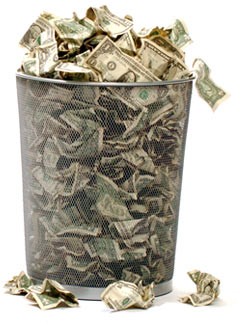
Have you ever heard the expression “Don’t throw good money after bad”? It means that sometimes there’s no way to salvage a bad situation, and you should stop trying and just walk away. After the Stock Market Crash of 1929 began, some people threw good money after bad trying to save the market, but they were doomed to failure, and the situation the nation was in only got worse. Click each row in this table to learn how.
| Stock Market Failure | A group of powerful financial leaders bought large amounts of stock to show the public that they still believed in the stock market. This move was along the same lines as Charles Mitchell’s $25 million loan, but this time private money did not solve the public problem. Private individuals could not possibly have bought enough stock to stop the Crash, as millions of stocks were being sold each day. In fact, this group's actions on October 29th only added to the volume, and the ticker-tape machines that printed out stock sales and prices on long sheets of paper (called tape) broke down under the strain of printing so many sales. The next day the number of sales slowed, but only because it was impossible to continue at that high volume. |
| Bottomed Out | The stock market continued to have a few small gains and many substantial losses through the rest of the year and into 1930. The highest stock market value ever recorded in the U.S. had been reached on September 3, 1929: 381.17. When the stock market hit bottom on July 8, 1932, it was worth just 41.22. |
| Bank Failures | Bankrupted by the stock market crash, people who took out loans from their banks to buy stocks could no longer make payments on those loans. Some banks ran out of money to lend and had to close. These were called bank failures. Other banks failed before they had completely run out of money: People still had money in their savings and checking accounts, but the banks anticipated that this would not be enough to keep them running and closed. Between 1930 and 1933, thousands of U.S. banks failed, and that meant that the money bank customers still had in the bank was used to pay off the banks’ creditors, so the customers ended up losing their money. There was no law to protect bank customers from losing their money in this way. |
| Bank Runs | Fear of bank failures led to bank runs: People who were scared that their bank would fail and close with all their money in it rushed to the bank to withdraw all their money. This, of course, only guaranteed that the bank would fail, but people were too scared of losing everything to care. All over the country, bank runs led to even more bank failures, and this meant it was even harder for businesses to borrow money to grow or to pay their workers until things got better. The economy grew even worse. |
Question
How did bank runs and bank failures affect the economy?
Question
How were bank failures harmful to the economy overall?
